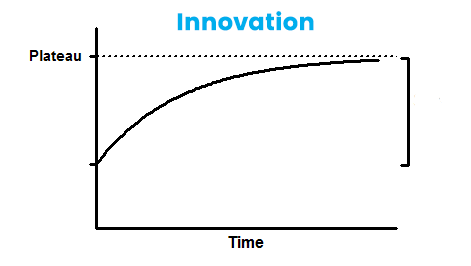Learn 7 ways taking a growth hacking marketing approach helps teams drive rapid business growth through innovation, experimentation, agility, and big ideas that move the needle.

In recent years, the term “Growth hacking” has climbed to the top of the most commonly used marketing buzzword list like an Adele song on the Billboard Hot 100. But like many-a-marketing-buzzword, its actual definition and practical application can seem ambiguous. So what does growth hacking really mean in the context of marketing? Here’s one (very) short definition:
Growth hacking marketing is a highly agile and experimental approach that typically leverages cost-effective modern digital marketing tactics to rapidly grow and scale a business.
To me, it’s about testing and finding the most efficient and effective ways to move the needle and make the biggest impact possible (as soon as possible) to build a tidal wave of long-term, sustainable growth.
If you happen to go to market with a super sexy, innovative and disruptive product, that certainly makes life a lot easier for an aspiring marketing growth hacker. But any company with a solid solution that solves problems for customers, good market potential, and a kick-ass team of marketers has the potential to do some serious growth hacking marketing damage.and won’t have to worry about a thing.
However, due to the nature of growth hacking marketing, the means to success can call for some significant internal shifts in mindset, approach, and culture for a marketing organization. It also elevates the importance of innovation, experimentation, “out-of-the-box-thinking” (ugh, I hate that phrase forgive me) and the need to stay nimble and agile.
7 Ways to Use a Growth Hacking Marketing Approach to Skyrocket Results

1. Not Being Afraid of Big, Bold Changes, Risks or Failure

This is probably an obvious one, but if you’re not on board with this, you probably should stop reading now.
If you want big results, you need to be willing to take big risks.
I’m not saying your marketing organization should be run like the wild west. Order and consistency is key to building a foundation for sustainable growth. But being super conservative all the time is not going to open the growth hacking flood gates.
Sometimes it takes a little calculated chaos and willingness to step out of your comfort zone in order to make real progress.
Learn from your mistakes, try not to make the same ones twice. But you need to be prepared to fail. Again. And again.
In my opinion, it’s not about making change for the sake of change, and just throwing absolutely everything at the wall and seeing what sticks. The big risks you take should be justified by a strong hypothesis, data, or analysis. And occasionally, you just have to trust your gut.
As they say, if you play with fire at some point you’re bound to get burned. But hey, that’s the price you pay for the chance of creating a spark that could ignite an organization.
Of course, you’ll hopefully be testing and monitoring every experiment, so you will always be able to quantify and minimize the damage.

2. The Google 10X Mindset
Google CEO Larry Page is famous for his philosophy that instead of focusing on ideas that can grow a business 10%, focus on the ones could grow a business 10x.

Sure, this mindset can be viewed as extreme, and perhaps not attainable or realistic from a goal-setting standpoint in many cases.
But in general, I think it’s good to at least keep that 10X in the back of your mind.
Whether the goal be revenue, leads, conversion rates, or whatever KPI you are trying to impact, if you’re always keeping your eyes open for those 10X ideas and opportunities, and taking a step back every once and a while to scan the big picture for them, at least you’re giving yourself a chance to spot any bottle-rocket opportunities that may appear.
The ones who see the most shooting stars are the ones always looking to the sky.
(I think I read that in a fortune cookie once.)
3. Cultivating a Culture of Testing to Drive Innovation

3 Essential Ingredients Needed to Drive a Culture of Innovation
- Ability to identify and understand important problems, and the levers and variables with potential to impact results and outcomes
- Steady and organic flow of ideas in an open environment that allows those ideas to integrate and evolve
- Constant experimentation and testing of hypotheses to enable constant learning and improvement
Getting a team into “test-mode” and encouraging a steady idea flow isn’t always easy, but in my experience, often #1 is the key to success for #2 and #3, and can be a greater challenge for a team.
For example, let’s say your team is all gung-ho about A/B testing and is peppering the wall with a million ideas. WOOP! That’s super awesome.
However, if everyone on the team doesn’t have a strong handle on identifying key problem areas that could have the biggest impact, and understanding the levers and variables to use, are all these tests and ideas things that truly have big growth hacking, needle-moving potential?
Considering the Google 10X mindset, is running another button color test in email really going drive significant business growth?

Incremental Tests VS “Revolutionary” Tests
I’m not saying that small, incremental tests and optimizations like the button color test example aren’t important – they absolutely are, and over time can accumulate to have a considerable impact. In my opinion you should have lots of these running regularly. But they’re not enough on their own.
To borrow another page (pun-intended) from Larry of Google fame’s book:

In growth hacking marketing, I think you need a balance of both incremental and “revolutionary” tests. But you’re certainly not going to get rocket ship level growth with just the incremental ones…
No Testing for the Sake of Testing!

You want every member of your team constantly thinking about variables they could test to improve results. But…
If you want to run experiments that really move the needle, and from which you can truly learn and gain valuable insights, do not fall into the bad habit of encouraging “testing for the sake of testing.”
In addition to focusing on needle-mover problem areas and understanding the levers to make an impact, the other key to avoiding “testing for testing’s sake” is reinforcing the golden rule that every test should have a hypothesis – a thought process behind how/why changing a specific variable could potentially impact the outcome of results.
7 Tips and Ideas for Establishing a “Culture of Testing”
- Seek external inspiration. Don’t live inside your own internal bubble. Subscribe to lots of email lists. Check out other companies’ websites regularly (as a bonus you’ll get their re-marketing ads), read blogs, watch videos, browse social feeds. All marketers get ideas from other marketers. And just as often, great work-related ideas can come from unexpected non-work-related sources. Just keep yourselves exposed.
- Encourage internal sharing. Facilitate regular sharing among the team. Test results, ideas, articles, external examples, data, anything people find interesting, share it with the team.
- Create a test/experiment idea backlog. Whenever someone has a test idea, throw it on a running list that the whole team has access to. Later you can pull from it on the fly whenever you see on opportunity.
- Document your tests and results. Have a centralized location where you can look back and see past tests, hypotheses and results. Use this also to help different team members learn from each others’ tests. “Oh, this ad copy worked well in PPC, let’s try it as an email subject line…” Maybe even use the documented tests to start compiling an internal growth hacking test/experiment hall-of-fame, or a conference presentation deck.
- Come up with creative incentives to encourage effective testing. Maybe have monthly contests and give out awards for top growth hacking tests that moved the needle for example. Encouraging friendly competition and giving recognition to individual team members for their successes can go a long way motivate the team.
- Place internal bets on test winners. Circulate tests before you run them and have people vote on which option they think will win. This is a good way to reinforce testing with a hypothesis, and to get people engaged and learning from each others’ tests.
- Harp on statistical significance. I almost didn’t include this because it’s obvious, but of course you need to collect enough data for a test result to be valid. This needs to be ingrained in everyone’s minds. There are several free calculators available to help with this, here’s one from KissMetrics.
4. The 1920s Paris Cafe: Establishing an Idea Incubator
 Anyone who knows me, knows how much I love and get excited about ideas. I also happen to love Paris, the Jazz Age, and anything Hemingway. To my own delight, they all happen to be applicable here. Allow me to explain…
Anyone who knows me, knows how much I love and get excited about ideas. I also happen to love Paris, the Jazz Age, and anything Hemingway. To my own delight, they all happen to be applicable here. Allow me to explain…
Where Good Ideas Come From, and the Importance of Collaboration
If you’re not familiar with Steven Johnson’s work on innovation and ideas called “Where Good Ideas Come From”, first of all, I would highly recommend checking out his Ted Talk, or if you’re crunched for time, this short video (also embedded below) which does a good job summarizing his thesis. I have always been a personal subscriber to Johnson’s theory on ideas and innovation.
According to Johnson, great ideas actually often are not conceived by just one person, or in one “EUREKA!” moment. Instead, typically it begins as just a fragment of an idea; a small “hunch” that forms in your mind and stews there for a while. This “hunch” might end up becoming a decent or even “good” idea in its own right, but usually not a “great” one. The idea is still incomplete.
Truly innovative and breakthrough ideas happen when that hunch in your mind collides with another hunch lurking in someone else’s mind, completing the idea and creating something greater than the some of its parts.

Thus, collaboration and idea-sharing are essential to creating a culture of testing and innovation. Naturally, this means people need to feel comfortable throwing ideas out there and sharing them with team members.
The goal is to create an environment in which those fragments of ideas and “hunches” can come together to form those big, impactful growth hacking marketing ideas.
Why do you think in the Jazz Age Ernest Hemingway, F. Scott Fitzgerald, Picasso, Gertrude Stein and so many other revolutionary thinkers spent half the 1920s in the cafes of Rue Montparnasse and Rue Saint-Germain? I mean, the gin certainly had something to do with it, but they were idea incubators! Hemingway and F. Scott wrote entire novels sitting at tables of those cafes. It was an environment of inspiration and creativity.

“Idea Incubators” for Growth Hacking Marketing Teams: 4 Keys to Success
- Ideas belong on the wall, but not all of them will stick (and that’s OK.) Many ideas you throw out there probably aren’t going to stick right away (or at all), and it’s important to create an environment where people feel comfortable with that and do not take it personally.
- Start with a problem. Whenever possible, make sure to start with a specific problem first. Be careful to avoid people coming up with ideas for solutions to problems that don’t exist or aren’t a priority. This wastes time, of which we have little to gamble with when in growth hacking marketing mode.
- Focus and prioritization. It’s also important to make sure ideation stays aligned with key goals, objectives and problems, that new ideas are being prioritized and weighed against existing initiatives and commitments, and you’re not trying to focus in too many different areas at once. This could be overwhelming for both employees and employers if you’re being drafted into too many areas at once. To organize any goals or objectives that your business has set in an effective way, and in a system that is easy to understand, incorporating OKR software from somewhere like Profit, can help you to clearly establish the goals that you have set yourself in an efficient manner, so they can be successfully achieved. It could help to make a difference.
- Clarity on ideas versus action items. Whenever you are talking about ideas, make sure it is clear to everyone involved that they are just ideas until they become formally designated as action items.
5. Knowing When to Press the Abort or Reset Buttons

Whether it be an experiment, project, strategy, process, team, anything – there are going to be times when something just isn’t working for a while, or you find yourself going too far down the wrong path, or see a more lucrative alternative path to long-term success.
When these things happen, you have to be open to the idea of aborting the mission, or just pressing reset and starting from scratch.
You hopefully won’t have to press it often, but in the world of growth hacking marketing, there’s no time to waste when there is action to be taken.
6. Taking an Agile Marketing Approach
For growth hacking marketing teams whose approach is centered around rapid change, adaptibility, and experimentation, the ability for the organization to stay flexible and nimble is a must.
More traditional, “waterfall” methodologies that favor rigid, long-term planning simply won’t work to support a growth hacking marketing style.
Rather, the practice of agile marketing, with the advantages of focusing on executing rapid, short-term, iterative work cycles called “sprints,” is an ideal format for a growth hacking marketing team.
Taking a look at the 7 core values of the agile marketing manifesto, it’s easy to see how perfectly these align with the growth hacker marketer mentality and approach.
9 Ways to Ensure Agile Marketing Success with Better Sprint Planning
7. The Long-Term Innovation Plateau: Overcoming the Internal Status Quo

Fast forward a couple of years. Your growth hacking marketing team and organization has been running on full cylinders for while. All the critical pieces and moving parts are in place, effective systems, processes, programs and strategies well-established, evolved and “perfected.” Most of the kinks have been worked out and rough edges smoothed. You’ve had many failures and successes and lessons learned along the way. Made tons of incremental optimizations. Your hacking experiments and innovative ideas have lead to big results. You’ve achieved a baseline of predictable, sustainable growth.
And now you are starting to see the innovation beginning to level off.
First of all, if that is the case, it might be time to revisit a Larry Page-esque 10X mindset to rally the team. There is always more room for innovation and improvement. It’s impossible for a digital marketer or team to ever be finished.
Second, now that we’ve finally gotten to this place, and this certain way of doing things has worked for us for a while, things can start to get set in stone and become common practice, standard operating procedure. “The way we do things.”
In other words, we’ve created our own internal status quo.
Any challengers or newcomers with prying questions or ideas, are often met with a “if it ain’t broke, don’t fix it” attitude.
After all, it took a lot of hard work and smart people to get to this point, and many complex problems that have been thought through and solved. Why focus here, if it’s already been figured out?
I’ve been on both ends of this spectrum in my career – the firm protector of the status quo, and the change agent challenging it.
As the protector of the status quo, you have every right and reason to defend the existing “way of things” you have in place. You’ve put in the sweat, blood and tears, learned the painful lessons first hand, seen what has worked and what hasn’t, and experienced the evolution of how we got to now.
(Side note: total random coincidence, but “How We Got To Now” is another awesome Steven Johnson series I would highly recommend that is definitely worth a good Netflix binge.)
So when your internal status quo is challenged, often you may be correct in defending the current approach. Maybe you’ll be right in saying it ain’t broken. You probably will be a lot of the time.
But then again, it might not be broken, but maybe it’s starting to crack. Maybe it has been for a while. Maybe your solution had only been a temporary fix. Maybe, just maybe, there had been a better way to approach it all along that you just hadn’t thought of. Maybe there’s a way to improve results 10X again. Maybe it’s time to press the reset button.
Perhaps someone else is growth hacking what you’ve previously growth hacked…

Will your mind be open to the idea of change?
What tips do you have for a marketing organization to succeed with growth hacking? Would love to hear your thoughts and comments.
“Not Being Afraid of Big, Bold Changes, Risks or Failure” We must not afraid to these things, all business is really risky. Its a nice post and thanks for sharing this post.